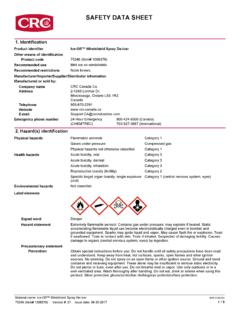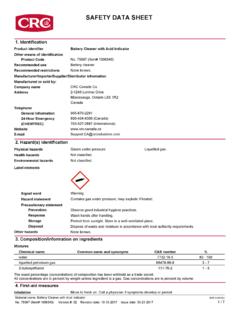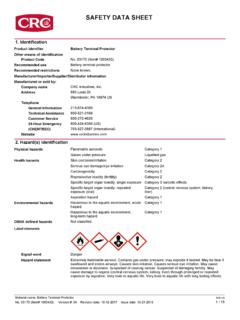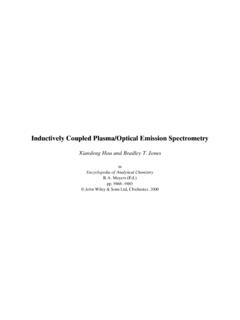Transcription of SAFETY DATA SHEET - CRC Industries
1 SAFETY data SHEET . 1. Identification Product identifier Heavy Duty Degreaser Other means of identification Product Code No. 03095 (Item# 1003364). Recommended use General purpose degreaser Recommended restrictions None known. Manufacturer/Importer/Supplier/Distribut or information Manufactured or sold by: Company name CRC Industries , Inc. Address 885 Louis Dr. Warminster, PA 18974 US. Telephone General Information 215-674-4300. Technical Assistance 800-521-3168. Customer Service 800-272-4620. 24-Hour Emergency 800-424-9300 (US). (CHEMTREC) 703-527-3887 (International). Website 2.
2 Hazard(s) identification Physical hazards Gases under pressure Compressed gas Health hazards Skin corrosion/irritation Category 2. Serious eye damage/eye irritation Category 2B. Sensitization, skin Category 1B. Carcinogenicity Category 1B. Specific target organ toxicity, single exposure Category 3 narcotic effects Environmental hazards Hazardous to the aquatic environment, acute Category 2. hazard Hazardous to the aquatic environment, Category 2. long-term hazard OSHA defined hazards Not classified. Label elements Signal word Danger Hazard statement Contains gas under pressure; may explode if heated.
3 Causes skin irritation. May cause an allergic skin reaction. Causes eye irritation. May cause drowsiness or dizziness. May cause cancer. Toxic to aquatic life with long lasting effects. Precautionary statement Prevention Obtain special instructions before use. Do not handle until all SAFETY precautions have been read and understood. Do not puncture or incinerate container. Do not expose to heat or store at temperatures above 49 C/120 F. Use with adequate ventilation. Open doors and windows or use other means to ensure a fresh air supply during use and while product is drying.
4 If you experience any symptoms listed on this label, increase ventilation or leave the area. Avoid breathing mist or vapor. Wash thoroughly after handling. Contaminated work clothing must not be allowed out of the workplace. Wear protective gloves. Avoid release to the environment. Material name: Heavy Duty Degreaser SDS US. No. 03095 (Item# 1003364) Version #: 03 Revision date: 12-19-2017 Issue date: 05-19-2014 1 / 10. Response If on skin: Wash with plenty of water. If skin irritation or rash occurs: Get medical advice/attention. Take off contaminated clothing and wash before reuse.
5 If inhaled: Remove person to fresh air and keep comfortable for breathing. Call a poison center/doctor if you feel unwell. If in eyes: Rinse cautiously with water for several minutes. Remove contact lenses, if present and easy to do. Continue rinsing. If eye irritation persists: Get medical advice/attention. IF exposed or concerned: Get medical advice/attention. Collect spillage. Storage Store locked up. Protect from sunlight. Store in a well-ventilated place. Exposure to high temperature may cause can to burst. Disposal Dispose of contents/container in accordance with local/regional/national regulations.
6 Hazard(s) not otherwise None known. classified (HNOC). Supplemental information When exposed to extreme heat or hot surfaces, vapors may decompose to harmful or fatal corrosive gases such as hydrogen fluoride, hydrogen chloride, and possibly phosgene. 3. Composition/information on ingredients Mixtures Chemical name Common name and synonyms CAS number %. tetrachloroethylene perchloroethylene 127-18-4 80 - 90. trans-1,2-dichloroethylene 156-60-5 5 - 10. carbon dioxide 124-38-9 1-3. decafluoropentane HFC 43-10mee 138495-42-8 1-3. Specific chemical identity and/or percentage of composition has been withheld as a trade secret.
7 4. First-aid measures Inhalation Remove victim to fresh air and keep at rest in a position comfortable for breathing. Call a POISON. CENTER or doctor/physician if you feel unwell. Skin contact Remove contaminated clothing immediately and wash skin with soap and water. In case of eczema or other skin disorders: Seek medical attention and take along these instructions. Wash contaminated clothing before reuse. Eye contact Immediately flush eyes with plenty of water for at least 15 minutes. Remove contact lenses, if present and easy to do. Continue rinsing. If eye irritation persists: Get medical advice/attention.
8 Ingestion Rinse mouth. If ingestion of a large amount does occur, call a poison control center immediately. Do not induce vomiting. Most important May cause drowsiness and dizziness. Headache. Nausea, vomiting. Irritation of eyes. Exposed symptoms/effects, acute and individuals may experience eye tearing, redness, and discomfort. Skin irritation. May cause delayed redness and pain. May cause an allergic skin reaction. Dermatitis. Rash. Indication of immediate Provide general supportive measures and treat symptomatically. Keep victim under observation. medical attention and special Symptoms may be delayed.
9 Treatment needed General information IF exposed or concerned: Get medical advice/attention. Ensure that medical personnel are aware of the material(s) involved, and take precautions to protect themselves. Wash contaminated clothing before reuse. 5. Fire-fighting measures Suitable extinguishing media Water spray. Water fog. Foam. Dry chemical powder. Carbon dioxide (CO2). Unsuitable extinguishing Do not use water jet as an extinguisher, as this will spread the fire. media Specific hazards arising from Pressurized container may rupture when exposed to heat or flame. During fire, gases hazardous to the chemical health may be formed.
10 When exposed to extreme heat or hot surfaces, vapors may decompose to harmful or fatal corrosive gases such as hydrogen fluoride, hydrogen chloride, and possibly phosgene. Special protective equipment Firefighters must use standard protective equipment including flame retardant coat, helmet with and precautions for firefighters face shield, gloves, rubber boots, and in enclosed spaces, SCBA. Fire fighting In case of fire: Stop leak if safe to do so. Move containers from fire area if you can do so without equipment/instructions risk. Containers should be cooled with water to prevent vapor pressure build up.











